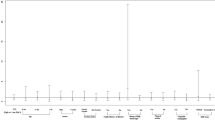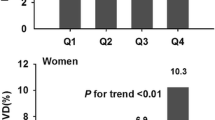Abstract
The aim of this study is to evaluate blood cadmium levels (BCLs) in Chinese adults and explore whether blood cadmium is associated with diabetes or obesity. This study included 5544 adults from a cross-sectional SPECT-China study. BCL and blood lead level (BLL) was measured by atomic absorption spectrometry. Fasting plasma glucose (FPG) was used to define prediabetes and diabetes. Overweight and obesity were defined by body mass index (BMI). The associations of BCL with prediabetes, diabetes, overweight, and obesity were analyzed by multinomial logistic regression analyses. Medians (interquartile range) of BCL were 1.97 μg/L (0.60–3.82) in men and 1.59 μg/L (0.54–3.51) in women. Subjects in low-economic-status areas and urban areas had significantly higher BCL. BCL in current smokers was significantly higher than in current non-smokers. In the adjusted model, a mild positive relationship between BCL and FPG was found. Meanwhile, the prevalence of prediabetes was increased according to the increase in BCL tertiles. Surprisingly, BCL had a negative relationship with prevalence of overweight. In conclusion, BCL in Chinese adults was much higher than in other developed countries and was influenced by gender, smoking, and residential area. BCL was positively related to prediabetes while negatively related to overweight.



Similar content being viewed by others
References
Afridi HI et al (2008) Evaluation of status of toxic metals in biological samples of diabetes mellitus patients. Diabetes Res Clin Pract 80:280–288. doi:10.1016/j.diabres.2007.12.021
Andersen O, Nielsen JB, Svendsen P (1988) Oral cadmium chloride intoxication in mice: effects of dose on tissue damage, intestinal absorption and relative organ distribution. Toxicology 48:225–236
Atkinson MA, Eisenbarth GS, Michels AW (2014) Type 1 diabetes. Lancet 383:69–82. doi:10.1016/s0140-6736(13)60591-7
Barregard L, Bergstrom G, Fagerberg B (2013) Cadmium exposure in relation to insulin production, insulin sensitivity and type 2 diabetes: a cross-sectional and prospective study in women. Environ Res 121:104–109. doi:10.1016/j.envres.2012.11.005
Barregard L, Bergstrom G, Fagerberg B (2014) Cadmium, type 2 diabetes, and kidney damage in a cohort of middle-aged women. Environ Res 135:311–316. doi:10.1016/j.envres.2014.09.017
Bergstrom G, Fagerberg B, Sallsten G, Lundh T, Barregard L (2015) Is cadmium exposure associated with the burden, vulnerability and rupture of human atherosclerotic plaques? PLoS One 10, e0121240. doi:10.1371/journal.pone.0121240
Bocca B, Madeddu R, Asara Y, Tolu P, Marchal JA, Forte G (2011) Assessment of reference ranges for blood Cu, Mn, Se and Zn in a selected Italian population. J Trace Elem Med Biol 25:19–26. doi:10.1016/j.jtemb.2010.12.004
Borne Y et al (2014) Cadmium exposure and incidence of diabetes mellitus—results from the Malmo Diet and Cancer study. PLoS One 9, e112277. doi:10.1371/journal.pone.0112277
Breton J, Massart S, Vandamme P, De Brandt E, Pot B, Foligne B (2013) Ecotoxicology inside the gut: impact of heavy metals on the mouse microbiome. BMC Pharmacol Toxicol 14:62. doi:10.1186/2050-6511-14-62
CDC (2013) Fourth National Report on Human Exposure to Environmental Chemicals (2013). Centers for Disease Control and Prevention National Center for Environmental Health Division of Laboratory Sciences Mail Stop F-20 4770 Buford Highway, NE Atlanta, GA 3041-33724
Chang KC et al (2013) Cadmium induces apoptosis in pancreatic beta-cells through a mitochondria-dependent pathway: the role of oxidative stress-mediated c-Jun N-terminal kinase activation. PLoS One 8:e54374. doi:10.1371/journal.pone.0054374
Chen YW, Yang CY, Huang CF, Hung DZ, Leung YM, Liu SH (2009) Heavy metals, islet function and diabetes development. Islets 1:169–176. doi:10.4161/isl.1.3.9262
Chen X et al (2014) Effects of lead and cadmium co-exposure on bone mineral density in a Chinese population. Bone 63:76–80. doi:10.1016/j.bone.2014.02.017
Chen C et al. (2015) Blood cadmium level associates with lower testosterone and sex hormone-binding globulin in Chinese men: from SPECT-China Study, 2014 Biological trace element research doi:10.1007/s12011-015-0526-x
Chung S et al (2014) Blood lead and cadmium levels and renal function in Korean adults. Clin Exp Nephrol 18:726–734. doi:10.1007/s10157-013-0913-6
Edwards JR, Prozialeck WC (2009) Cadmium, diabetes and chronic kidney disease. Toxicol Appl Pharmacol 238:289–293. doi:10.1016/j.taap.2009.03.007
El Muayed M et al (2012) Accumulation of cadmium in insulin-producing beta cells. Islets 4:405–416. doi:10.4161/isl.23101
Garcia-Esquinas E, Navas-Acien A, Perez-Gomez B, Artalejo FR (2015) Association of lead and cadmium exposure with frailty in US older adults. Environ Res 137:424–431. doi:10.1016/j.envres.2015.01.013
Gochfeld M (2007) Framework for gender differences in human and animal toxicology. Environ Res 104:4–21. doi:10.1016/j.envres.2005.12.005
Hambach R et al (2013) Co-exposure to lead increases the renal response to low levels of cadmium in metallurgy workers. Toxicol Lett 222:233–238. doi:10.1016/j.toxlet.2013.06.218
He P et al (2013) Exposure assessment of dietary cadmium: findings from Shanghainese over 40 years. China BMC Public health 13:590. doi:10.1186/1471-2458-13-590
Heitland P, Koster HD (2006) Biomonitoring of 37 trace elements in blood samples from inhabitants of northern Germany by ICP-MS. J Trace Elem Med Biol 20:253–262. doi:10.1016/j.jtemb.2006.08.001
Johri N, Jacquillet G, Unwin R (2010) Heavy metal poisoning: the effects of cadmium on the kidney. Biometals 23:783–792. doi:10.1007/s10534-010-9328-y
Ke S, Qiao S (2013) Cadmium toxicity is much more terrible than the beast: preliminary studies of adverse health effects of cadmium pollution in China. Huaxia Press, Beijing
Lee BK, Kim Y (2015) Association of blood cadmium level with metabolic syndrome after adjustment for confounding by serum ferritin and other factors: 2008-2012 Korean National Health and Nutrition Examination Survey Biological trace element research doi: 10.1007/s12011-015-0499-9
Nawrot TS, Martens DS, Hara A, Plusquin M, Vangronsveld J, Roels HA, Staessen JA (2015) Association of total cancer and lung cancer with environmental exposure to cadmium: the meta-analytical evidence. Cancer Causes Control: CCC 26:1281–1288. doi:10.1007/s10552-015-0621-5
Ng M et al (2014) Global, regional, and national prevalence of overweight and obesity in children and adults during 1980-2013: a systematic analysis for the Global Burden of Disease Study 2013. Lancet (London, England) 384:766–781. doi:10.1016/s0140-6736(14)60460-8
Padilla MA, Elobeid M, Ruden DM, Allison DB (2010) An examination of the association of selected toxic metals with total and central obesity indices: NHANES 99-02. Int J Environ Res Public Health 7:3332–3347. doi:10.3390/ijerph7093332
Sacks DB (2011) A1C versus glucose testing: a comparison. Diabetes Care 34:518–523. doi:10.2337/dc10-1546
Schwartz GG, Il’yasova D, Ivanova A (2003) Urinary cadmium, impaired fasting glucose, and diabetes in the NHANES III. Diabetes Care 26:468–470
Scinicariello F, Buser MC (2014) Blood cadmium and depressive symptoms in young adults (aged 20–39 years). Psychol Med 45:807–815. doi:10.1017/s0033291714001883
Swaddiwudhipong W, Limpatanachote P, Mahasakpan P, Krintratun S, Punta B, Funkhiew T (2012) Progress in cadmium-related health effects in persons with high environmental exposure in northwestern Thailand: a five-year follow-up. Environ Res 112:194–198. doi:10.1016/j.envres.2011.10.004
Trevino S, Waalkes MP, Flores Hernandez JA, Leon-Chavez BA, Aguilar-Alonso P, Brambila E (2015) Chronic cadmium exposure in rats produces pancreatic impairment and insulin resistance in multiple peripheral tissues. Arch Biochem Biophys 583:27–35. doi:10.1016/j.abb.2015.07.010
Wallia A, Allen NB, Badon S, El Muayed M (2014) Association between urinary cadmium levels and prediabetes in the NHANES 2005-2010 population. Int J Hyg Environ Health 217:854–860. doi:10.1016/j.ijheh.2014.06.005
Wang G, Fowler BA (2008) Roles of biomarkers in evaluating interactions among mixtures of lead, cadmium and arsenic. Toxicol Appl Pharmacol 233:92–99. doi:10.1016/j.taap.2008.01.017
Wang N et al (2015a) Blood lead level and its association with body mass index and obesity in China—results from SPECT-China study. Scientific reports 5:18299. doi:10.1038/srep18299
Wang N et al (2015b) Is exposure to famine in childhood and economic development in adulthood associated with diabetes? J Clin Endocrinol Metab 100:4514–4523. doi:10.1210/jc.2015-2750
WHO (1992) Cadmium (Environmental Health Criteria 134). http://www.inchem.org/documents/ehc/ehc/ehc134.htm
Xu Y (2013) Jama 310:948. doi:10.1001/jama.2013.168118
Zhang YX, Wang SR (2013) Rural-urban comparison in prevalence of overweight and obesity among adolescents in Shandong, China. Ann Hum Biol 40:294–297. doi:10.3109/03014460.2013.772654
Acknowledgments
The authors thank Weiping Tu, Bin Li, and Ling Hu for helping organize this investigation.
The authors thank Xiaojin Wang and Bingshun Wang from the Department of Biostatistics, Shanghai JiaoTong University School of Medicine for data processing.
The authors also thank all team members and participants from Shanghai, Zhejiang, and Jiangxi Province in the SPECT-China study.
Author information
Authors and Affiliations
Corresponding authors
Ethics declarations
Conflict of interest
The authors declare that they have no conflict of interest.
Authors’ contributions
Xiaomin Nie, Ningjian Wang, and Yi Chen researched the data and wrote the manuscript. ChiChen and Bing Han researched the data. Chunfang Zhu, Yingchao Chen, Fangzhen Xia, Zhen Cang, Meng Lu, Ying Meng contributed to the discussion. Michael D. Jensen, Boren Jiang, and Yingli Lu reviewed the manuscript.
Funding
This study was supported by National Natural Science Foundation of China (81270885, 81070677, 81570726); Clinical Potential Subject Construction of Shanghai JiaoTong University School of Medicine (2014); Ministry of Science and Technology in China (2012CB524906); Science and Technology Commission of Shanghai Municipality (14495810700); and Fund for outstanding academic leaders in Shanghai (12XD1403100).
Additional information
Responsible editor: Philippe Garrigues
Xiaomin Nie, Ningjian Wang and Yi Chen contributed equally to this work.
Electronic supplementary material
Below is the link to the electronic supplementary material.
ESM 1
(DOCX 14 kb)
Rights and permissions
About this article
Cite this article
Nie, X., Wang, N., Chen, Y. et al. Blood cadmium in Chinese adults and its relationships with diabetes and obesity. Environ Sci Pollut Res 23, 18714–18723 (2016). https://doi.org/10.1007/s11356-016-7078-2
Received:
Accepted:
Published:
Issue Date:
DOI: https://doi.org/10.1007/s11356-016-7078-2




